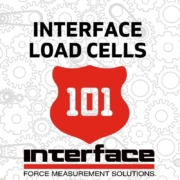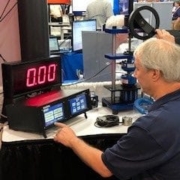Driving Force in Automotive Applications
 Among the most highly regulated industries in the world, automotive is up there with the likes of medical and defense. Every component and system needs to be thoroughly tested and deliberately analyzed to ensure that the final product is safe for the driver, other vehicles and pedestrians. Any mistakes or failures can cause catastrophic damage and put lives at risk.
Among the most highly regulated industries in the world, automotive is up there with the likes of medical and defense. Every component and system needs to be thoroughly tested and deliberately analyzed to ensure that the final product is safe for the driver, other vehicles and pedestrians. Any mistakes or failures can cause catastrophic damage and put lives at risk.
There are hundreds of thousands of different tests that car parts and software go through before they are approved for the road. Among them is force measurement testing. Force and torque tests are integral to the structural and mechanical design and build of the car. Gathering data on the build quality and safety of materials and components found within cars, trucks and more is done through a wide variety of different force measurement testing.
Interface has been a partner to the automotive industry for more than 50 years, from the major OEMs to smaller parts manufacturers and test labs. We build force and torque sensors and acquisition devices designed to provide automotive engineers and manufacturers with high-quality data to monitor and confirm the design and in-action processes of a wide variety of vehicles.
Force testing applications for the automotive industry involve everything from structural, engine, brake, seat belt and suspension tests, all the way down to individual lug nut torque testing.
Recently, Interface has also been supplying solutions to those in the growing electrical vehicle (EV) market. EV cars and other motor vehicles present a wide variety of unique challenges for engine torque and battery technology testing.
As an example of some of the products we offer to the industry, we are highlighting Interface expertise in different automotive applications. This will include specific examples of work we’ve done for our customers recently or in the past.
BRAKE PEDAL TESTING 
One of the largest areas of automotive test and measurement we are involved in is brake pedal testing. Our customers need to ensure that applying certain amounts of force to the brake will slow and stop the vehicle as intended.
In this application note, Interface supplied our customer with a BPL-300-C Brake Pedal Load Cell, which was installed on the brake pedal. As the user depressed the brake pedal, force data was transmitted by our BTS-AM-1 Bluetooth Low Energy (BLE) Strain Bridge Transmitter Module to the BTS Toolkit Mobile App and displayed on a mobile device. This allowed our customer to view and graph the data in real-time.
Read the application note for Brake Pedal Testing here.
EV BATTERY TESTING
In the EV market, one of the most integral pieces of technology is the battery used to run every piece of hardware and software in the car. One of the critical tests that’s performed on EV batteries in compression testing. As an EV battery is charged and stores more electrons, it swells. If the packaging that houses the batteries is not intelligently designed to compensate for this swelling, you could have a major problem.
For this challenge, Interface can supply the popular WMC Miniature Load Cell. The load cell will measure compression force as a battery goes through charge cycles on a test stand to determine the force given off as the battery swells. This allows our customers to design the proper packaging for the batteries.
Read more about Interface’s role in the The Future of Automotive is Electric.
 SUSPENSION TESTING
SUSPENSION TESTING
A personal favorite of the Interface team is a suspension test we performed on a race car. As you can imagine, race car components need to be finely tuned for optimal performance. The suspension is one of the most significant factors in the tuning process.
Using an Interface Model 1200 Standard Load Cell, we were able to measure simulated motions of a racetrack including bumps, banks and other track conditions. This allowed the customer to gather highly accurate (0.04%) measurements of loads applied to individual suspension points. This type of suspension testing technology can also be performed on a regular commercial automobile, but the race car example is much more fun!
View the race car suspension testing application here.
MOTOR TESTING
In this motor test stand application, it was used in the quality control lab of a major automotive manufacturing customer that needed to test, record and audit the torque produced by a new motor design under start load.
Interface supplied a Model AxialTQ Rotary Torque Transducer that connected between the motor and the differential, on the drive shaft, which could measure and record these torque values. Based on the data collected using the AxialTQ, AxialTQ Output Module, and customer laptop, the test engineer was able to make recommendations to optimize the amount of torque created by the new motor design.
You can read more about the AxialTQ in this post.
The wide variety of applications for automotive force testing that Interface has been involved in is significant. We have many published application notes beyond those highlighted, including Seat Testing, Engine Head Bolt Tightening and one for an Engine Dynamometer (dyno for short) use case. The examples listed above just scratch the surface.
Interface is a preferred partner to the automotive industry. To review some of the automotive application notes we have published, please check out our website at /solutions/automotive-vehicle/. You can also give us a call to learn more about the various solutions we offer for customers in the automotive industry at 480-948-5555.








